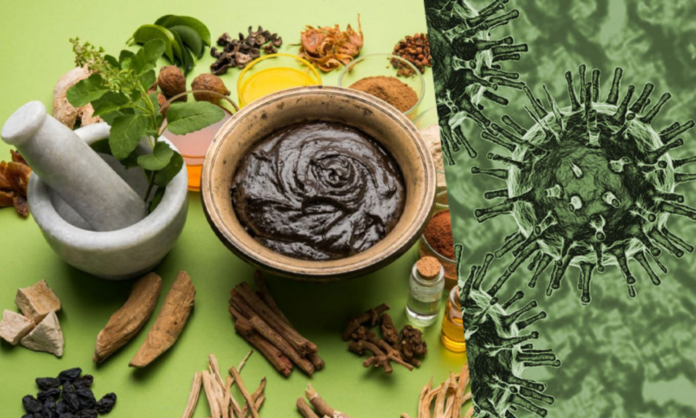The Ayurvedic Treatments for Long COVID
Dr. Indrajeet Tyagi and Dr. Iranna Hirapur
Although most people with COVID-19 return to their normal state of health after acute infection in 2-4 weeks, but a significant proportion report persistent life-altering health problems.
It is difficult to predict who will experience long COVID however, the continuous symptoms as well as remitting and relapsing patterns do also occur morein women and be linearly related to age.
Long COVID can occur irrespective of the initial severity of infection, and often affects multiple organ systems such as heart, lungs, kidneys, liver, pancreas, or spleen. Many individuals have more than one organ affected and it is unknown so far how and when these chronic symptoms will resolve.
Studying long COVID syndrome is especially difficult because there is such a wide range of health issues involved — from shortness of breath to “brain fog” to fatigue to insomnia to cardiovascular problems to polyneuropathies to depression, and even rare cases of psychosis andthere is no consensus on how to define, diagnose or measure this syndrome using modern medical technology. COVID-19 can result in prolonged illness due to following sequelae.
Neurologic sequelae: Coronavirus is primarily a respiratory virus causing symptoms range from mild, such as headache, nausea, anosmia (loss of smell), ageusia (loss of taste), altered consciousness, “brain fog” to more severe such as hemorrhage, syncope, seizure, stroke, meningoencephalitis, Guillain-Barre syndrome, and demyelinating disease. The exact pathologic basis for these neurologic symptoms is currently unknown despite the understanding of the “spike protein”, that builds many copies during the infection, can readily cross the blood brain barrier and lodge in the gray matter of the brain and this toxic spike protein subunits also enter the spleen, liver and kidneys.
Cardiac sequelae: According to previous studies, although cardiac abnormalities and myocardial inflammation were not associated with initial COVID-19 severity. At the same time, evidence of cardiac injury in long COVID is not only rising but also observing cardiac symptoms such as chest pain, heart palpitations, and tachycardia that commonly persist among COVID-19 survivors for 6-12 months or longer, suggesting substantial cardiac sequelae. Individuals with orthostatic hypotension along with tachycardia condition are at risk for vasovagal syncope.
Gastrointestinal, renal, and musculoskeletal sequelae: Long COVID may also affect the gastrointestinal system and patients may experience abdominal pain, gastrointestinal bleeding, nausea and vomiting, diarrhea, hepatitis, and pancreatitis. People who experienced kidney dysfunction during many other acute illness periods are more likely to have continued kidney dysfunction as time passes but researchers are uncertain how this will affect COVID-19 long-haulers. The musculoskeletal symptoms of myalgias and arthralgias are also very common complaints among long-haulers and often misdiagnosed as fibromyalgia.
Skin sequelae: Dermatologic symptom associated with COVID-19 infection include skin lesions such as morbilliform rash (“measles-like”) and chilblain-like acral lesions, “COVID toes (pink, red or purplish bumps).” may develop up to 2 weeks after acute COVID-19 infection and normally resolve within 4 to 8 weeks, but can persist.
Immunity sequelae: Some people who have recovered from COVID-19 have decreased immune systemactivity and it can also have the opposite effect, causing parts of the immune system to become overactive and trigger harmful uncontrolled inflammation throughout the body. At this time, it is unclear how long it takes the immune system to regain balance and normalcy. A recent study has revealed that increased risks of new respiratory, diabetes, and cardiovascular diseases occurring within the subsequent six months among COVID-19 patients.
What are the Ayurveda concepts of post-acute COVID-19 infection/long COVID?
Agnimandya Avastha – a state of low ‘agni’/digestive fire.
Visharoga – accumulation of toxic substances (Visha = toxin), which cause cellular dysfunction, and in extreme cases death.
Dhatu-Kshaya – weakening and loss of bodily tissues or Dhatus.
Ojakshaya – Loss of ojas/vital force. This is the most devastating and disabling effect of long COVID.
What Ayurvedic treatments are necessary and effective for long COVID?
The following Ayurvedic treatments are recommended for long COVID. Consult a qualified Ayurvedic doctor for your right treatment.
Deepana-Pachana Chikitsa is used to correct Agnimandya Avastha by administrating gentle spices, and medicinal herbs to re-constitute and re-strengthen the Jatharāgni (principal digestive fire), and dhatwagis (tissue-level digestion and assimilation) as well as removal of accumulated Ama from the tissues. Ama is a sticky endogenous metabolic poisonous substance that is the result of improper or incomplete digestion. Because long COVID involves the accumulation of Ama, Deepana-Pachana treatment is essential.
Panchakarma is suggested to correct both Visharoga and removal of Ama(cellular and metabolic poisons) accumulation. These two are closely related. There are five purifying procedures to be individually adopted to purify and reestablish proper function of cells, organs, and body systems.Shirisha (Albizia lebbeck) and Haridra Churna/turmeric root powder (Curcuma longa) which are recommended to be started following Panchakarma and after clinical recovery from the acute condition.
Pathya vyavastha or regulation of the diet (pathya)
Ayurveda considers food as the first and foremost factor in the tripod of life (food, sleep, brahmacharya). A proper diet is vital and mandatory for maintenance of good health, resistance to disease, and for the healing from disease. Pathya vyavastha primarily is knowledge about appropriate and inappropriate foods for different diseases and how to enhance the therapeutic effect of diet, maintain digestion power, and aid in the assimilation of nutrients and Prana from the diet.
COVID-19 has been stressing and deteriorating our individual immunity as well as our collective herd immunity as the world was already in a very vulnerable condition and ripe for a widespread diseases due to the consumption of processed and ultra-processed foods. A “processed food” refers to any food that has undergone a physical change before it is consumed.
This can include canning, smoking, pasteurizing, crushing, boiling, freezing and drying and examples include canned vegetables, canned broths, salted nuts, canned tuna fish, canned salmon, canned sardines, plain yogurt, tofu, cheese, or smoked meats. Ultra-processed foods include white bread, white rice, plain white pasta, noodles, regular flour products, foods made from refined grains, cereals, crackers, sugary cakes, donuts, cookies, candy, ice cream, soft drinks, energy bars, flavored yogurt. Therefore, eat unprocessed or minimally processed foods such as apples, bell peppers, spinach, bananas, unsalted nuts, or fresh salmon, and any food in its natural state.
Dhatu-ojo-poshana or systematic re-nourishment of the bodily tissues and replenishment of Ojas includes the administration of formulations of COVID-specific Rasayana remedies. Although a healthy, balanced diet is the primary tool for this, a considerable amount of plant medicines, and spices can play an important role in creating healthy tissues and organ systems which are resistant to diseases like COVID and cancers.
One formulation found to be effective for many people is a decoction made from Draksha (Vitis vinifera), Amalaki (Emblica officinalis), Guduchi (Tinospora cordifolia), Vasa (Justicia adhatoda), and Ashwagandha (Withania somnifera) for at-least 45 days.
Several plants such as Sanguisorba officinalis L, Stephania tetrandra S. Moore (tetrandrine, fangchinoline, and cepharanthine), and Strobilanthes cusia (Nees) Kuntze (tryptanthrin), and F. suspensa (Thunb.) Vahl (forsythoside A) are able to inhibit the viral RNA and protein synthesis.
Various herbs that contain quercitin and kaempferol are also used asRasayana plants to protect against COVID infection.
(Authors: Dr. Indrajeet Tyagi, M. R. Medical College, Kalaburagi, Karnataka and Dr Iranna S. Hirapur, MD, DM (Cardiology) Interventional Cardiologist at Heart Foundation,Kalaburagi, Karnataka)
Also Read: Ayurvedic and Homeopathic Management of Cellulitis







